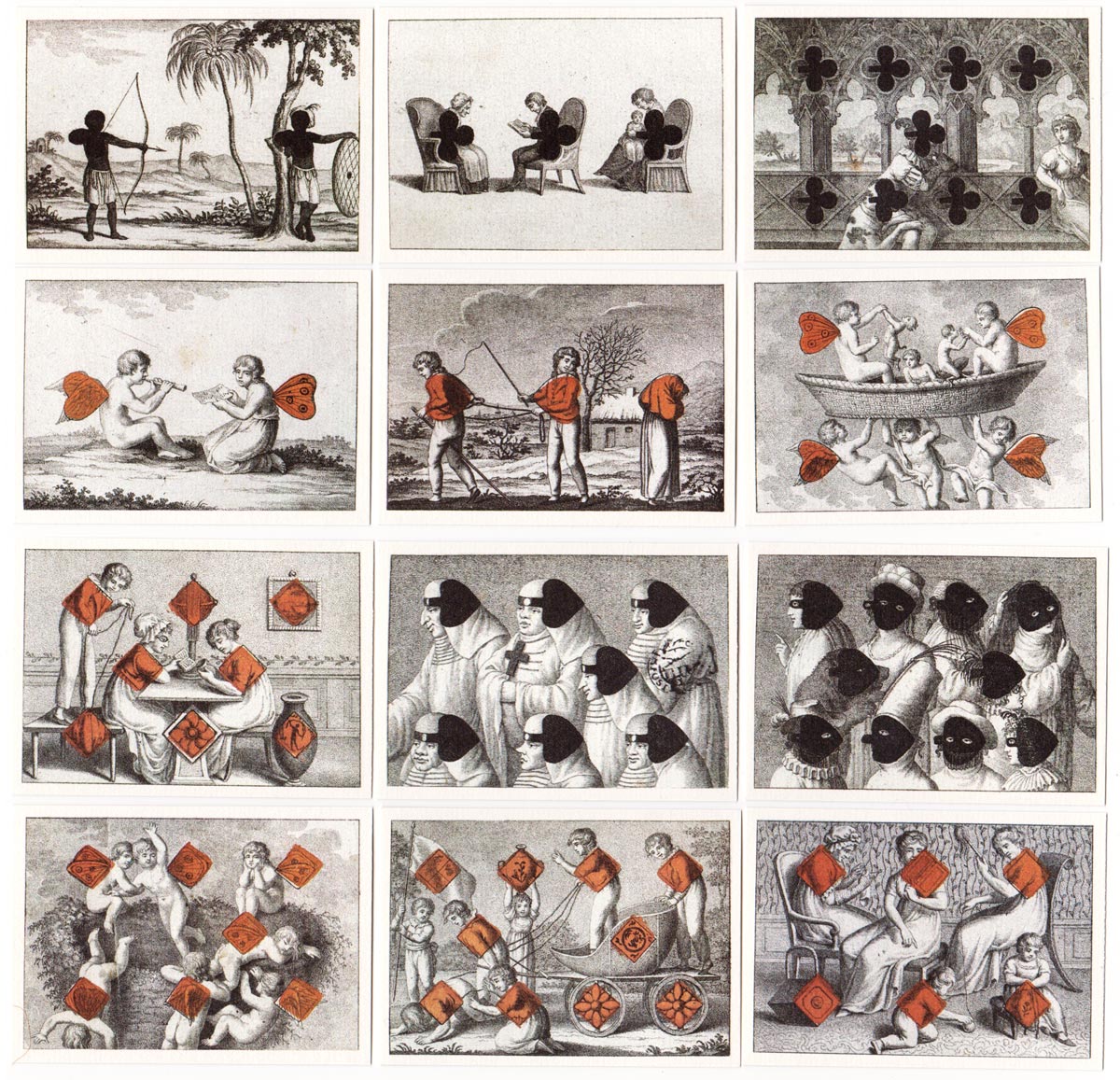Cotta Transformation playing cards
In 1804, J.G. Cotta, a publisher and bookseller in Tübingen, Germany, produced the first set of transformation cards that was published as an actual deck of playing cards.
Cotta Transformation playing cards, 1804
In 1804, J. G. Cotta, a publisher and bookseller in Tübingen, Germany, produced the first set of transformation cards that was published as an actual deck of playing cards, designed by Charlotte von Jennison-Walworth. The court cards depict characters from Friedrich von Schiller's tragedy Die Jungfrau von Orleans (The Maid of Orleans) but the transformed pip cards are unrelated. This art form probably began as a parlour game in late 18th century England for the entertainment of ladies and gentlemen, but since then transformation cards have become one of the most popular fantasy creations in playing cards and often showcase a high level of creative art and skill. You can play it yourself at home... take a piece of card and mark five or six suit symbols, then players must create a figure from these...

Above: Cotta's Transformation playing cards, first published in Tübingen, Germany, in 1804. These decks were published as almanacs, each card corresponding to one of the 52 weeks of the year. Cards shown here are from the facsimile edition published by Baptiste-Paul Grimaud (France-Cartes) in 1984. 52 cards + extra card in presentation box.

By Simon Wintle
Member since February 01, 1996
I am the founder of The World of Playing Cards (est. 1996), a website dedicated to the history, artistry and cultural significance of playing cards and tarot. Over the years I have researched various areas of the subject, acquired and traded collections and contributed as a committee member of the IPCS and graphics editor of The Playing-Card journal. Having lived in Chile, England, Wales, and now Spain, these experiences have shaped my work and passion for playing cards. Amongst my achievements is producing a limited-edition replica of a 17th-century English pack using woodblocks and stencils—a labour of love. Today, the World of Playing Cards is a global collaborative project, with my son Adam serving as the technical driving force behind its development. His innovative efforts have helped shape the site into the thriving hub it is today. You are warmly invited to become a contributor and share your enthusiasm.
Related Articles

OH Cards
A Series of Metaphoric Cards to unlock your story, conceived and designed by Ely Raman

VEB Kombinat Kali
Advertising pack depicting old means of salt production, with designs by Hannelore Heise.

Burghausen
Historical figures and buildings to promote the town of Burghausen, with designs by Jonny Petri.

Wiener Pattern – Nuremberg Version
A classic deck in a new illustrative style, with notable variations in line work, detail, and colour...

CARD-AB Miltenberg
Illustrations by Rita Stern depicting notable landmarks and scenes from the town of Miltenberg in Ge...

New Altenburg Skat cards – German DDR Pattern
Authentic Altenburger Skat cards with German suits (Acorns, Hearts, Leaves, Bells).

German Travel Cards
A travel-themed educational deck helping American tourists visiting Germany.

French Revolutionary cards by Pinaut
Seven cards from a French Revolutionary pack by Pinaut featuring characters from classical antiquity...

An Anonymous Belgian Transformation Pack
Anonymous Belgian transformation pack borrowing many images from earlier designs by Braun & Schneide...

Briefmarken-Quartett
Quartet game featuring postage stamps from the Zones of Occupation in post-WWII Germany.

IG Chemie Papier Keramik
Promotional pack designed by Karl-Heinz Schroers for a German trade union with comical bears on the ...

Engel-Tarot
Set of major arcana designed by Alois Hanslian depicting angels throughout.

Virgil Solis
Remarkable pack of 52 animal-suited playing-cards designed and etched by Virgil Solis.

Politiker-Skat by Bubec
Caricatures of world leaders, including many German politicians, by the artist Bubec.

Le Poker Politique
French politicians and various world leaders caricatured by the German artist Bubec.

Rouen Pattern - Portrait Rouennais
An attractive XV century French-suited design from Rouen became the standard English & Anglo-America...
Most Popular
Our top articles from the past 28 days






